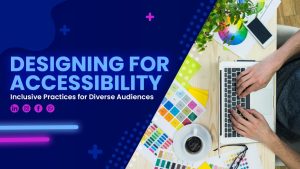Typography isn’t just about style it’s a critical part of user experience. For millions of users with visual or cognitive impairments, poor typography can make content unreadable. That’s why accessible typography isn’t just a design preference; it’s a necessity.
Typography that works for everyone means going beyond aesthetics and considering how different users interact with your content. You may consider this : over 2.2 billion people globally have some form of vision impairment, according to the World Health Organization. If your font choice and formatting aren’t inclusive, you’re closing the door on a massive audience.
Why Accessible Typography Matters
Accessible typography helps users read, understand, and engage with your content regardless of their ability level. Good design doesn’t leave anyone behind.
Visually impaired users, those with dyslexia, cognitive disabilities, or even users reading on small screens or in low-light environments benefit from well-considered typography. This isn’t just a compliance issue it’s about building trust, improving usability, and expanding reach.
Key Elements of Accessible Typography
Designing inclusive typography involves more than choosing a legible font. Here are the core elements to consider:
1. Font Choice
- Sans-serif fonts like Arial, Helvetica, and Verdana are easier to read on screens than serif fonts.
- Avoid decorative or script fonts for body text they reduce clarity, especially at smaller sizes.
2. Font Size and Line Spacing
- Body text should be at least 16px for web readability.
- Maintain line spacing (line-height) of about 1.5x the font size for clear separation of lines.
3. Color and Contrast
- High contrast between text and background enhances readability. Use tools like the WebAIM Contrast Checker to ensure compliance.
- Avoid using color alone to convey meaning pair color changes with icons or text cues.
4. Line Length and Text Alignment
- Ideal line length is 50–75 characters per line. Longer lines make it hard to track; shorter lines can be choppy.
- Left-align text for most languages. Centered or justified text reduces readability and flow.
5. Text Hierarchy and Emphasis
- Use headings ( <h1> to <h6> ) correctly to establish structure not just for style.
- Bold important points sparingly. Avoid using ALL CAPS, as they are harder to read and feel aggressive.
Actionable Tips to Improve Typography Accessibility Today
- Test with real users. Use screen readers and browser zoom to experience your site as others might.
- Provide text resizing. Allow users to adjust font sizes without breaking layout.
- Use semantic HTML. Screen readers rely on correct HTML structure to navigate content.
Real-World Benefits of Inclusive Typography
Designing with accessibility in mind improves usability for all users not just those with disabilities. Think about someone reading your content on a smartphone in bright sunlight. Or an older user with mild vision loss.
Inclusive typography also contributes to better SEO and lower bounce rates. When people can read your content easily, they’re more likely to stay, engage, and return.
